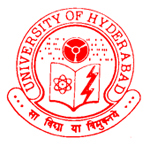Prof. Dr. Musti J. Swamy
University of Hyderabad
School of Chemistry
Hyderabad - 500046
India
| Email: | mjssc@uohyd.ernet.in |
Professor Musti J. Swamy has about 25 years of research and 13 years of teaching experience. His research group at the University of Hyderabad, School of Chemistry, has been working for about 13 years on various aspects of plant lectins, a group of proteins which recognize carbohydrate structures in a specific manner. So he has authored/co-authored about 75 research papers including several reviews, of which over 40 research publications deal with lectins. Some of the salient features of his research contributions on plant lectins are outlined below.
Purification, characterization and sugar-binding properties of Cucurbitaceae lectins:
Dr. Swamy’s group purified several Cucurbitaceae seed lectins in high yield and characterized them in detail with respect to their macromolecular properties, carbohydrate binding specificity and interaction with porphyrins. Employing isothermal titration calorimetry (ITC) Dr. Swamy delineated the thermodynamic forces that stabilize the interaction between various saccharides and the Momordica charantia seed lectin. These studies are particularly important because there have been very few previous studies dealing with Cucurbitaceae seed lectins. Since some of these species are rather unique to the Indian subcontinent and lectins are of considerable use in a variety of biomedical applications including analytical and preparative biochemistry as well as in tumour diagnosis, applications developed with these lectins can be commercially exploited.
Porphyrin binding to plant lectins and relevance to photodynamic therapy:
Dr. Swamy and his colleagues have shown for the first time that plant lectins such as Concanavalin A, Jacalin, T. cucumerina seed lectin (TCSL), Momordica charantia lectin (MCL) etc. bind porphyrins with affinities that are comparable to their affinity for sugars and that in solution, the porphyrin binding occurs at a site different from the saccharide-binding site. Since porphyrins are used in photodynamic therapy (PDT) for cancer treatment, and many lectins preferentially recognise tumour cells, this suggests that lectins can potentially be used for the targeted delivery of porphyrins to tumour cells. Thermodynamic analysis by his group has shown that while porphyrin binding to TCSL is governed primarily by favourable entropic factors, binding to M. charantia lectin is mediated by both enthalpic forces. Their kinetic studies have demonstrated that porphyrin binding to TCSL is four orders of magnitude slower than diffusion controlled reactions. These results are relevant for using lectins for the specific targeting of porphyrins to tumour tissues in PDT.
Techniques used:
In pursuing the different objectives of his research, Prof. Swamy has made extensive use of a variety of biophysical methods including absorption spectroscopy, fluorescence spectroscopy, FTIR spectroscopy, CD spectroscopy, ESR spectroscopy, Differential Scanning Calorimetry (DSC), Isothermal Titration Calorimetry (ITC), Stopped-Flow and Temperature-jump studies for investigating the kinetics.
Germany related:
Did a post-doctoral stint at the Max-Planck Institut für biophysikalische Chemie, Göttingen (with Prof. Dr. Derek Marsh, Aug. 1990 – March 1993) and has collaborated with the same group extensively later on. Acquainted with the German culture and language.



